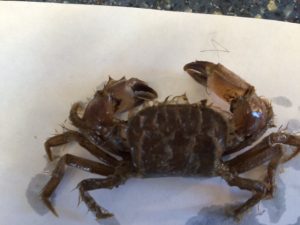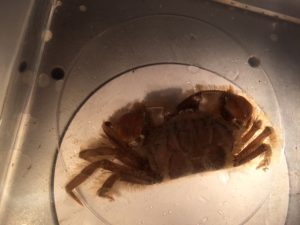The effects of the warm-water “Blob” and 2015 ENSO event are still being seen in 2016. On October 28, 2016 Dr. Rikke Jeppesen and her team of researchers captured a strange crab at South Marsh in the Elkhorn Slough National Estuarine Research Reserve (ESNERR). While checking a minnow trap, scientists observed and collected an unidentified crab (male, carapace width 23.7 mm) caught in the trap.

“At first, we thought it was a Chinese Mitten Crab,” said Jeppesen, “but the lack of white claw tips and lack of four spines between the eye and lateral margin, indicated otherwise. Also a mitten crab carapace is round, while this one was much more rectangular.” Jeppesen consulted local marine biologists, but no one could identify the crab species.
Jeppesen sent photos of the mystery crab Dr. Greg Jensen at the University of Washington. Jensen, an expert in marine arthropods and author of Crabs and Shrimps of the Pacific Coast: A Guide to Shallow-Water Decapods from Southeastern Alaska to the Mexican Border (2014), identified the crab as the California Burrowing Crab, Malacoplax californiensis.
“Interestingly, Greg Jensen said the northern most record of this species is Morro Bay,” said Jeppesen. “Well, not anymore.”
The minnow trap was set on muddy substrate at about a 0 ft tidal height at the South Marsh study site, which has a marine salinity and some nearby rip-rap. Researchers monitor native crab and invasive crab populations using dead anchovies as bait in minnow traps.
The number of anomalous occurrences of species beyond their known range limit has been very high in the last three years due to the Blob and ENSO. The Blob is an area with “substantially warmer-than-average water temperatures in the northern Pacific Ocean” and present on the west coast from late 2013 through 2015. Species from warmer, more southern parts of the west coast have been found in more northern waters, which are normally too cold for these species, but were hospitable during the Blob and ENSO events.

Malacoplax californiensis normally occurs from Baja California, Mexico up to Morro Bay, California. Jensen notes in his field guide that it “builds burrows in the middle and low intertidal of muddy bays and estuaries and also reported to hide under objects on mud flats” like rip-rap or large clam shells. Jensen also notes that this species was common in the early part of the 20th century but is rarely encountered.
Key characteristics include a carapace that is nearly rectangular, black-tipped chelipeds (claws), and much of the body is fringed with “hair.” This is a small crab, with a maximum reported carapace width of 31.3 mm (1.2 inches).